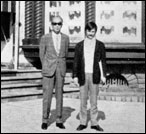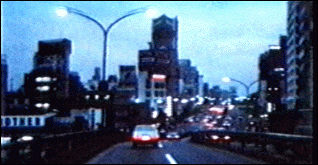
Kurosawa AkiraA Dream is a GeniusThe below is an excerpt from KUROSAWA Akira's book A Dream is a Genius, pp. 180-182 (ISBN 4-16-355570). Edited by Bungeishunju. ©1999 Bungeishunju. Translated from Japanese by Nostalghia.com Japan correspondent SATO Kimitoshi. 
Every film by Tarkovsky is marvelous, indeed. He was especially marvelous in handling the Water Element, as seen, for example, in Solaris and Sacrifice. He was somehow able to shoot a pond or water pool as transparent as to allow us to see through to the very bottom. You know, if you do it in an ordinary way, you will for sure find the sky reflected on the water surface. I, too, wanted to shoot water as he did, in making an episode of the Village of Watermills in Dreams. Can you imagine what we did to achieve that? We set up huge cranes soaring to the sky to put up a huge black cloth to prevent the sky reflection on the water surface. Now the riverbed became visible. You know, the crew on the space station in Solaris suffer from the longing to return to Planet Earth. That is why we see a long, long series of sequences of nature on earth, such as waterweeds softly dancing in a river. It makes the audience really want to return to Earth, indeed. The Japanese distribution company told me to leave a bit of it out, because nature shots were too long. If you had done so, the film should have become meaningless. After all, my insistence saved the film from being cut. This shows that there is something a little bit difficult about his films. I am sure, however, that it is to his great merit. His films are somehow a little bit different from the rest of many ordinary films easy to understand. I hear his father is a famous poet. So Andrei has a great poetic talent and quality. Tarkovsky told me that he always sees Seven Samurai before shooting his new films. This is to say that I always see his Andrei Rublov before shooting. [...]
Andrei was an amicable, charming man. I heard
he was in hospital in Paris when I was staying in Europe. I was
anxious to inquire after him, and desperately tried to find out the
hospital, until at last I had to give up because of the departure time
of the plane. [...] Soon after that, I got news of his death. Well, in
short, somehow, I always felt as if he was my younger brother.

This book was published in 1999, one year after Kurosawa's death. It is composed of three sections: Chapter 1 Kurosawa in Monologue, Chapter 2 Kurosawa in Dialogue, and Chapter 3 Kurosawa's death. Chapter 3 contains a section called 100 films of Kurosawa's choice. It is edited and compiled by Kazuko Kurosawa, his daughter, who writes in her preface: "My father always said that the films he loved were too many to count, and to make a top ten rank. That explains why you cannot find in this list many of the titles of the films he regarded as wonderful. The principle of the choice is: one film for one director, entry of the unforgettable films about which I and my father had a lovely talk, and of some ideas on cinema that he had cherished but did not express in public. This is the way I made a list of 100 films of Kurosawa's choice. Solaris is number 66 on "the list," and the corresponding caption reads as follows:
"I was on very intimate terms with Tarkovsky. I always felt like he was my younger brother. Drinking together, we sang the theme of Seven Samurai together. His expression of water element! it was unique, indeed. Watching this film always makes me want to return to Earth." Footnote: Number one on the list is Withering Flowers, 1919 by Griffith, and Number 100 is Hana-bi, 1997 by Takeshi. A draft translation of the whole list is found here
See also: |

